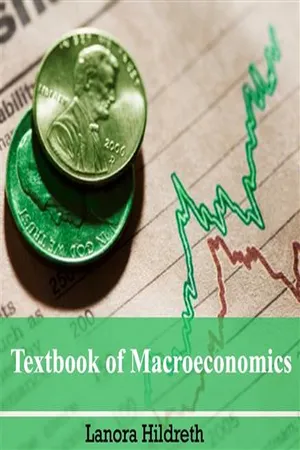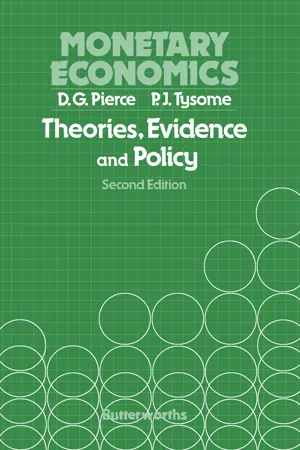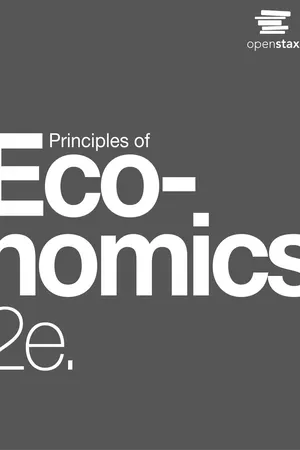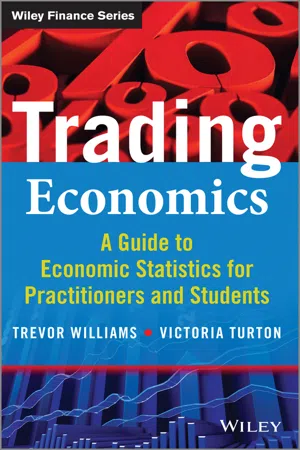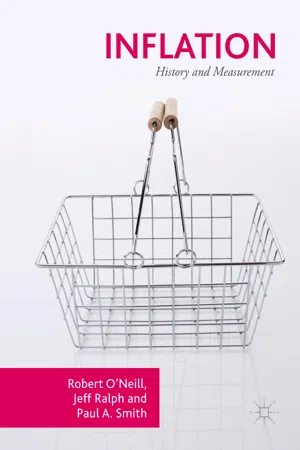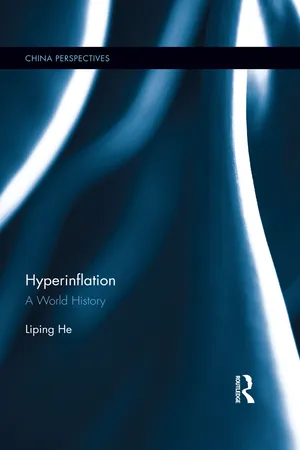Economics
Types of Inflation
The types of inflation include demand-pull inflation, which occurs when aggregate demand exceeds aggregate supply, leading to increased prices; cost-push inflation, caused by a decrease in aggregate supply due to increased production costs; and built-in inflation, resulting from expectations of future price increases leading to higher wages and prices. Each type has distinct causes and implications for the economy.
Written by Perlego with AI-assistance
Related key terms
1 of 5
7 Key excerpts on "Types of Inflation"
- No longer available |Learn more
- (Author)
- 2014(Publication Date)
- White Word Publications(Publisher)
There are three major Types of Inflation, as part of what Robert J. Gordon calls the triangle model: • Demand-pull inflation is caused by increases in aggregate demand due to increa-sed private and government spending, etc. Demand inflation is constructive to a faster rate of economic growth since the excess demand and favourable market conditions will stimulate investment and expansion. • Cost-push inflation , also called supply shock inflation, is caused by a drop in aggregate supply (potential output). This may be due to natural disasters, or increased prices of inputs. For example, a sudden decrease in the supply of oil, leading to increased oil prices, can cause cost-push inflation. Producers for whom oil is a part of their costs could then pass this on to consumers in the form of increased prices. • Built-in inflation is induced by adaptive expectations, and is often linked to the price/wage spiral. It involves workers trying to keep their wages up with prices (above the rate of inflation), and firms passing these higher labor costs on to their customers as higher prices, leading to a 'vicious circle'. Built-in inflation reflects events in the past, and so might be seen as hangover inflation. Demand-pull theory states that the rate of inflation accelerates whenever aggregate demand is increased beyond the ability of the economy to produce (its potential output). Hence, any factor that increases aggregate demand can cause inflation. However, in the long run, aggregate demand can be held above productive capacity only by increasing the quantity of money in circulation faster than the real growth rate of the economy. Another (although much less common) cause can be a rapid decline in the demand for money, as happened in Europe during the Black Death, or in the Japanese occupied territories just before the defeat of Japan in 1945. - eBook - PDF
Monetary Economics
Theories, Evidence and Policy
- David G. Pierce, Peter J. Tysome(Authors)
- 2014(Publication Date)
- Butterworth-Heinemann(Publisher)
Inflation Inflation is a term which has been used to mean several different things, but for the purposes of this chapter we shall define it to be a sustained rise in the general level of prices. Two points about this definition need emphasizing. First, the increase in prices must be a sustained one, and not simply a once and for all increase in prices. Second, it must be the general level of prices which is rising: increases in individual prices which are offset by falling prices are not inflationary. To people born since the start of the Second World War it may seem hard to believe that inflation is not inevitable, but there have been notable periods of falling prices in the UK during the last three hundred years. In fact the index of prices in 1913 was lower than that of 1661. During the present century, prices rose sharply during the First World War, but fell for most of the inter-war period. The Second World War again saw prices rising rapidly and, in contrast to much of the peacetime experience of the previous three hundred years, they have continued to rise ever since. The 1970s was, for the United Kingdom, the most inflationary decade of the century. The inflation of that decade was unusual moreover, not only for its severity, but also for being accompanied by historicially high levels of unemployment. Over the years many theories have been developed by economists to explain the nature and causes of inflation and various classifications have been used to group the theories together for purposes of comparison and contrast. In the 1950s and early 1960s, for example, it was common practice to distinguish between 'demand -puir and 'cost-push' explanations. This classification tried to distinguish between inflations that resulted from prices being pulled up by an excess demand for goods and services, and those that resulted from prices being pushed up by rising costs. - eBook - PDF
- Steven A. Greenlaw, Timothy Taylor, David Shapiro(Authors)
- 2017(Publication Date)
- Openstax(Publisher)
A relative price change occurs when you see that the price of tuition has risen, but the price of laptops has fallen. Inflation, on the other hand, means that there is pressure for prices to rise in most markets in the economy. In addition, price increases in the supply-and-demand model were one-time events, representing a shift from a previous equilibrium to a new one. Inflation implies an ongoing rise in prices. If inflation happened for one year and then stopped, then it would not be inflation any more. This chapter begins by showing how to combine prices of individual goods and services to create a measure of overall inflation. It discusses the historical and recent experience of inflation, both in the United States and in other countries around the world. Other chapters have sometimes included a note under an exhibit or a parenthetical reminder in the text saying that the numbers have been adjusted for inflation. In this chapter, it is time to show how to use inflation statistics to adjust other economic variables, so that you can tell how much of, for example, we can attribute the rise in GDP over different periods of time to an actual increase in the production of goods and services and how much we should attribute to the fact that prices for most items have risen. Inflation has consequences for people and firms throughout the economy, in their roles as lenders and borrowers, wage-earners, taxpayers, and consumers. The chapter concludes with a discussion of some imperfections and biases in the inflation statistics, and a preview of policies for fighting inflation that we will discuss in other chapters. - eBook - PDF
Trading Economics
A Guide to Economic Statistics for Practitioners and Students
- Trevor Williams, Victoria Turton(Authors)
- 2014(Publication Date)
- Wiley(Publisher)
4 Inflation Inflation is always and everywhere a monetary phenomenon in the sense that it is and can be produced only by a more rapid increase in the quantity of money than in output. Milton Friedman 1 WHAT IS INFLATION? Inflation tells us the changing (increasing) price of a range of goods or services; basically how much of something we can get for our money. The rate of change of prices – the speed at which the price of goods and services that are bought by households or businesses alter – is called inflation. But prices can also fall, in a process called deflation, sometimes termed negative inflation. Inflation is more common than deflation, or at least it has been in the last 50 years or so, and so it has become associated with changes in the price of goods and services. Historically, however, price falls were as common as price rises, as we will see later. Both inflation and deflation have advantages and disadvantages, which we will explore in more detail later in this chapter. THE HISTORY OF INFLATION Inflation has been around for a long time, but, as Figure 4.1 shows, the level of prices (the index) really only rose consistently and sharply in the UK from the 1970s onwards. This was after the US came off the gold standards and the Bretton Woods system of fixed exchange rates, which had prevailed after the Second World War, ended. Money was now backed by government fiat and trust rather than by gold. And exchange rates were no longer fixed but allowed to float freely. This seems to have led to a rapid rise in the level of prices or, in other words, to the Retail Prices Index. Before that, for hundreds of years, the level 1 Friedman, M., The Counter-Revolution in Monetary Theory (1970). 100 Trading Economics Retail Price Index (1987 = 100) 0 10 20 30 40 50 60 70 80 90 100 1264 1296 1328 1360 1392 1424 1456 1488 1520 1552 1584 1616 1648 1680 1712 1744 1776 1808 1840 1872 1904 1936 1968 2000 Figure 4.1 Price index over time. - eBook - PDF
Inflation
History and Measurement
- Robert O'Neill, Jeff Ralph, Paul A. Smith(Authors)
- 2017(Publication Date)
- Palgrave Macmillan(Publisher)
For many people, a definition of inflation as the increase in the price levels experienced in an economy may be enough for them to be happy that they understand it. However, for those of a statistical mindset, the 1 We note here that we are deliberately keeping away from the contentious phrase ‘maintaining a fixed standard of living’, which will be discussed more fully in later chapters. 2 See, for example, Mankiw and Taylor (2017), p. 583 or Sloman et al., p. 262. 2 What Is Inflation? 23 definition of inflation we have offered is likely to call to mind questions regarding what the price level experienced by people in an economy is and how we go about measuring it when we are in a situation in which we do not have complete information regarding prices and quantities involved in economic transactions. It is, however, worth noting that the rest of this book is focused on how changes in price levels are measured by statisticians and how they relate to the original concept of inflation which we often see defined at a fairly high level. If these questions did not come to mind when you read or heard the definition of inflation mentioned above then it is hoped that this book will help you see that they are important for understanding the phenomenon of inflation and its measurement. If you immediately questioned how the price level might be measured, we hope this book will provide at least a partial solution to the questions you are asking. Alongside the definition of inflation, we will also often hear econo- mists make use of the term deflation which the OED defines as a reduc- tion in the level of prices in an economy. 3 This refers to periods of time in which the level of prices, however measured, is declining, rather than increasing as is the more common situation in modern economies. - eBook - PDF
- Steven A. Greenlaw, David Shapiro, Daniel MacDonald(Authors)
- 2022(Publication Date)
- Openstax(Publisher)
We have 22.5 • Indexing and Its Limitations 549 barely hinted at the causes of inflation, and we have not addressed government policies to deal with inflation. We will examine these issues in depth in other chapters. However, it is useful to offer a preview here. We can sum up the cause of inflation in one phrase: Too many dollars chasing too few goods. The great surges of inflation early in the twentieth century came after wars, which are a time when government spending is very high, but consumers have little to buy, because production is going to the war effort. Governments also commonly impose price controls during wartime. After the war, the price controls end and pent-up buying power surges forth, driving up inflation. Otherwise, if too few dollars are chasing too many goods, then inflation will decline or even turn into deflation. Therefore, we typically associate slowdowns in economic activity, as in major recessions and the Great Depression, with a reduction in inflation or even outright deflation. The policy implications are clear. If we are to avoid inflation, the amount of purchasing power in the economy must grow at roughly the same rate as the production of goods. Macroeconomic policies that the government can use to affect the amount of purchasing power—through taxes, spending, and regulation of interest rates and credit—can thus cause inflation to rise or reduce inflation to lower levels. Inflation in a Pandemic—A Return to the 1970s, or a Temporary Adjustment? The pandemic-induced recession caused all sorts of disruptions to our economy, including inflation. During the pandemic, the prices for goods like gas and cars fell as people shifted to remote work and canceled travel plans. But as the economy started to recover from the pandemic in early 2021, we started to see large increases in these prices. Higher prices were also fueled by the injections of cash into the economy through stimulus checks and unemployment benefits. - eBook - PDF
- He Liping(Author)
- 2017(Publication Date)
- Routledge(Publisher)
Modern periods of inflation have been closely related to these factors. When infla-tion occurs in a country over a period of time, people can often identify at least one of the five factors. Clearly, though, these factors are not sufficient conditions for inflation, not to mention hyperinflation. In a paper currency system, for instance, deflation can occur as much as inflation. In the 2010s, many governments around the world run budget deficits, yet their national economies barely see any signifi-cant inflation. For hyperinflation to arise, something else must be in effect. Often before a period of hyperinflation, an economy has already experienced substantial inflation, which the government has already attempted to contain through certain policy measures. Hyperinflation very rarely occurs all of a sudden, without any early warning signs. Rather, hyperinflation usually results from previous inflation that has eventually escalated to an astronomical level. Therefore, hyperinflation has its own causes, distinctively different from those of “ordinary” inflation, the following three of which are the most relevant: • Policy failure in an inflation stabilization process; • Institutional deficiency that causes the public to lose trust in the government and confidence in a stabilization process; and • International isolation. 6 Introduction Understanding these three points requires a little knowledge of the framework of modern finance, in which governments play the role of money creator. Milton Friedman’s popular statement that “substantial inflation is always and everywhere a monetary phenomenon” 8 captures the essence of the quantity theory of money, which says the relation between money supply and price level in an economy at any point in time is constant under given economic conditions. In plain words, this relation implies that price inflation cannot rise beyond the maximum level the money supply could possibly accommodate.
Index pages curate the most relevant extracts from our library of academic textbooks. They’ve been created using an in-house natural language model (NLM), each adding context and meaning to key research topics.
